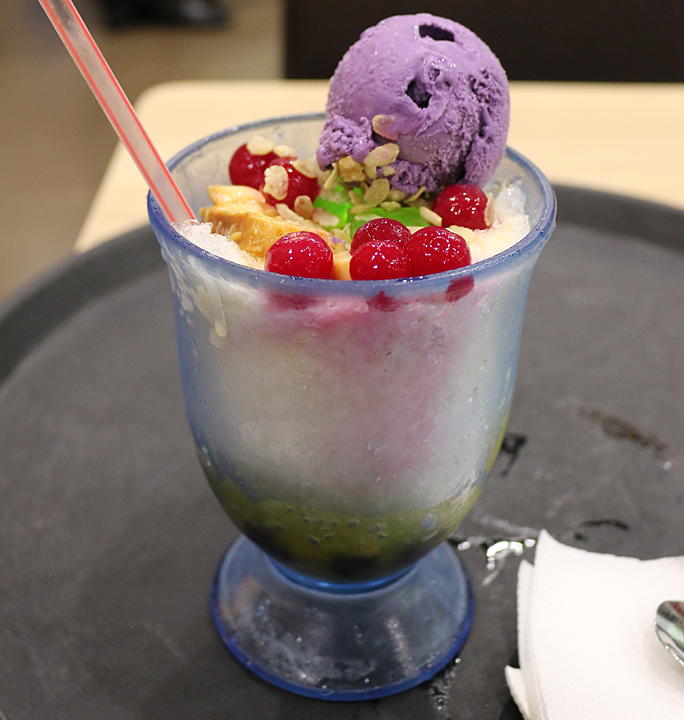I had never heard of halo-halo, which is a popular dessert in the Philippines comprised of a plethora of ingredients which can vary. Basically, it contains a mixture which includes but is not limited to chick peas; kidney beans; macapuno, which is preserved shredded young coconut; plantains; and kaong, which are sugar palm nuts — all caramelized in sugar; nata de coco, which is a gel created from the fermentation of coconut water; langkâ, which is jackfruit; gulaman, which is dried seaweed used to create jellies; tapioca; kamote, which is a type of sweet potato; pinipig, which is pounded crushed young rice; and cheese. It is typically served in a tall glass — similar to one used for ice cream sundaes — with shaved ice, sugar and evaporated milk; and topped with leche flan; ubeng pula, which is a purple yam; and ice cream.
Many of these ingredients did not appeal to me — but I just had to try it while I was in Manila. My halo-halo had the purple yam — or ube — ice cream, which contributed to the amazingly colorful dessert you see in the photograph at the top of this article.
I dug into it and was immediately greeted with an explosion of rich flavors — many of which were new to me. Each bite represented a different sensation with a plethora of textures: crunchy from the crushed ice; rubbery from the nata de coco and gulaman; mealy and pasty from the beans and chick peas; creamy from the evaporated milk and ice cream — and aside from the crushed ice, all of the ingredients competed with varying sweetnesses; yet simultaneously complemented each other.
The rubbery gelled parts of this dessert were what I enjoyed the most, I have to admit.
The halo-halo was quite refreshing — especially after walking around Manila on a warm and humid afternoon…
…but as I kept eating, I strangely found myself liking the dessert less and less. Contributing factors included the novelty wearing off on the new tastes and textures as I dug deeper into the dessert and that I already consumed most of the colorful parts of the dessert; but the main reason was similar to what I do not like about soft drinks containing ice: it was watered down towards the bottom due to the melting of the crushed ice.
Alternating between the straw and the metal spoon did not help. Eating this dessert towards the end started to get annoying, for a lack of a better word — it was not fun to eat anymore — so I left over the remains of what became a cold sweet watery ice soup.
Please do not let that last part deter you from trying halo-halo. People have asked me if I am originally from Europe because I always order soft drinks without ice, which I do for two reasons: I do not like my drink to be watered down at any time; and I get more soft drink for the money. Similarly, I was not crazy about my dessert becoming watered down. I have always been that way — what can I tell you?
I know quite a few people who enjoy munching on ice — whether it is crushed or cubed. I am not one of those people, which could also account towards the lessening of my enjoyment of halo-halo. Perhaps the fact that I do not care for sweet potato or evaporated milk or beans in my dessert might have also been a factor.
Maybe this is similar to those people who enjoy the tops of muffins but not the stumps?
Despite my review, do not pass up the opportunity to spend a buck or two and try a halo-halo if you find yourself in the Philippines, as I found it to be better than I expected overall and unlike any other dessert I have ever eaten — and I understand that this dessert has been available in parts of the United States in recent years. Also, keep in mind that there are many variations and interpretations of the halo-halo; so if you do not like one, you might like another.
I would likely try it again; but I would also likely not finish it…
Photograph ©2014 by Brian Cohen.

